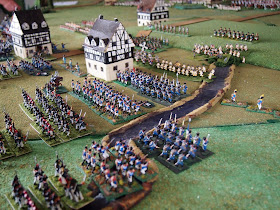The Mercenary forces are nearest, with not all the Carthaginians yet visible - in particular, you cannot yet see their formidable elephants. I was in charge of the Mercenaries, and I decided on a miniature Cannae plan - hold back my few heavy infantry and medium cavalry, whilst throwing forward the javelin-armed skirmishers, the Numidian light cavalry and the Celtic warband in the hope of destroying the elephants, and make the Carthaginians pay for every step forward they took. For Hanno's plan I would have to wait...
The evidence of my strategy can be clearly seen in the following photo from Move 2:
And the elephants did not have it all their own way, as the clash the following move on the right demonstrated. They don't like them up 'em, those elephants. Still, there were the Carthaginian's own light cavalry to deal with yet.
Go the Celtic Warband! At last, something of an opportunity for the big double units to make a dent in the Carthaginian heavy infantry. A flank attack was irresistible, but the inevitable result was an attack in turn by the Carthaginian light cavalry, and the unedifying but sadly predictable sight of fleeing Gauls.
What is left of the Celtic Warband is still making trouble the following Move, 4, but the Hands of God are stayed, Man must make his own destiny.
Normally Impetus games of this size run for about 6-8 turns, but my strategy of refusing the centre almost inevitably meant that after six moves, only the auxiliary troops had been heavily involved. Gradually, however, the main forces tipped into the fray, starting with the Carthaginian cavalry themselves, sweeping away skirmishers and plunging forward towards their Greek foes. Here, God singles out the one who is to die.
whilst here, in this overall view of Move 8, God contemplates the carnage He has created. The extent to which the Carthaginian left had been pierced can be clearly seen in this picture.
The awful reckoning could not long now be delayed, however, and on Move 9, the Carthaginian heavy infantry launched their long-awaited assault on the rebel lines. Here they are about to do so:
It went well, with the Libyans thrown back, narrowly averting a complete disaster by pulling back their cavalry just in time (note to myself: do not station cavalry too close to infantry lines).
But then a worried, and then a very worried, look crossed Hanno's brow: his losses had been steadily mounting, especially among relatively high-value units including infantry, and as Move 10 arrived, and the casualties mounted, the awful truth became evident: the Carthaginian army had gone beyond its break point, and the battle was over. Too many javelins thrown by too many Numidians to deal with, was the truth of the matter.
In real time, we had started about 11am and finished around 6pm, which we thought was extremely reasonable. Luck had swung back and forth, as it usually does, but the Mercenary plan had more or less held together, and had turned out better than Hanno's, which I extracted from him during his crucifixion - just attack.
Then we turned to the online sources, and found that we had understood things awry. In fact, this battle had been won by the Mercenaries after all. I must say, it was extremely pleasing that we had ended up recreating more or less the historical result despite thinking it had actually gone the other way. Impetus held up well, despite its sometimes cranky mechanics, and provided a lively, to-and-fro game with the result in doubt until the last moment. This won't be the last such encounter, Rome can rest assured of that...

































































